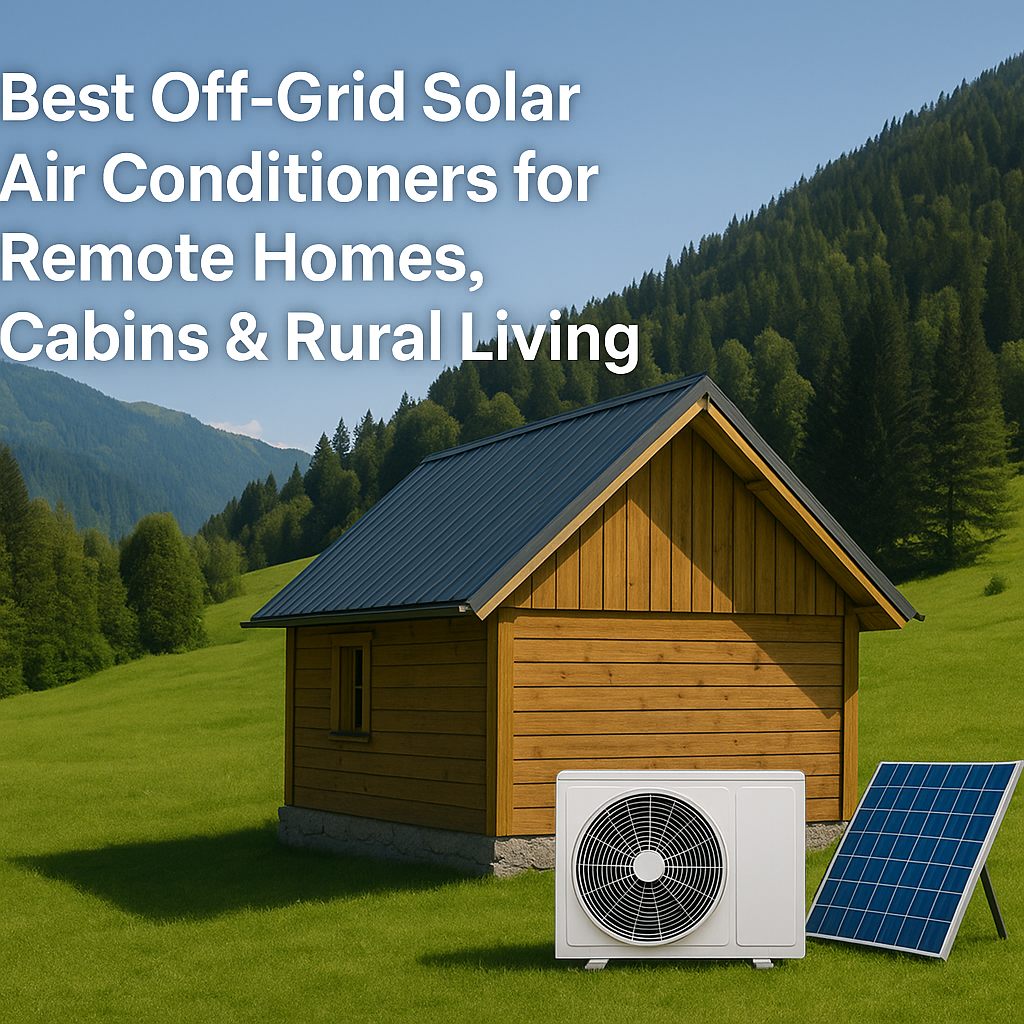Introduction
Imagine living miles from the nearest power line, in a serene cabin nestled among the pines, yet still enjoying refreshingly cool air during sizzling summer days. Off-grid solar air conditioners make this scenario possible—without costly electricity bills or reliance on noisy generators. This guide dives into the most practical, efficient, and cost-effective ways to bring comfortable air conditioning to off-grid dwellings, no matter how remote.

Key Takeaways
Solar-powered ACs deliver comfort in remote locations while minimizing environmental impact and energy costs.
Types include DC, hybrid, and fully off-grid systems, each with different setups and trade-offs.
Key considerations: your daily cooling needs (BTUs), battery/inverter compatibility, climate, and system scalability.
Benefits: energy independence, resilience during grid failures, and long-term savings—even if initial investment is higher.
Potential drawbacks: upfront cost, need for accurate sizing and weather-related performance limits.
What Is an Off-Grid Solar Air Conditioner?
An off-grid solar air conditioner is a cooling system powered entirely—or primarily—by solar energy, bypassing the need for grid electricity.
1.Some systems can be hybrid, seamlessly integrating solar power during the day and switching to the grid as a backup—though these aren’t fully off-grid during grid outages
2.It relies on solar panels to generate electricity, often stored in batteries for night or cloudy periods.
Why It Matters
- Energy independence: Stay comfortable even in blackout zones or during outages.
- Eco-friendly cooling: Cuts carbon emissions dramatically compared to grid-based systems.
- Dropping costs: Solar panels and components have become far more affordable, making solar ACs more viable
Who Benefits Most
- Remote homeowners with no reliable power infrastructure.
- Cabin or tiny-home dwellers prioritizing sustainability and independence.
- Off-grid enthusiasts aiming for resilience and eco-conscious solutions.
- Emergency preparedness users, especially in disaster-prone or unstable-grid areas.
What to Do: Choosing & Designing Your System
How to Choose: What to Look for in Your Off-Grid Solar AC
- Type of AC System:
- DC off-grid units: Run directly on battery voltage (e.g., 12V, 24V, or 48V)—no inverter needed, simpler, but rely entirely on batteries.
- Hybrid systems: Use solar when available, grid as backup; good for partial off-grid setups.
- Cooling Power (BTUs):
- Small cabins or vans: 6,000–8,000 BTUs
- Larger spaces or hot climates: 9,000–12,000+ BTUs
- Match BTUs to your space to balance efficiency and comfort .
- Electrical Compatibility:
- DC systems suit battery setups, with minimal loss.
- 48V systems provide lower current at the same power, reducing wiring losses.
- Energy Storage:
- Lithium batteries give efficiency and lifespan.
- Battery bank should cover night and cloudy-day demand.
- Sizing and Climate Fit:
- Assess your peak cooling needs and local solar potential.
- Sunny regions like the Southwest US are ideal, though panels are still viable in cloudy regions thanks to growing efficiency
Impact on Industry, Customers & the Environment
- Industry Trends: Modular, plug-and-play solar ACs are gaining traction. Hybrid systems lower installation friction, and DC power trends boost compatibility with other off-grid appliances.
- Customer Advantages: Less dependence on grid reliability, reduced energy costs over time, and increased resilience during disasters.
- Environmental Benefits: Cut CO₂ emissions, reduce fossil fuel reliance, and enable wider adoption of off-grid living lifestyles
Pros & Cons
| Pros | Cons |
|---|---|
| Self-sufficient cooling with zero utility bills | High initial setup cost for panels, batteries, inverters |
| Works during grid outages or in remote/off-grid areas | Battery maintenance and capacity planning required |
| Eco-friendly, renewable-based cooling | Requires correct sizing and may underperform in cloudy areas |
| Scalability and modern solar tech reduce complexity | Hybrid reliance may still need grid connection |
Step-by-Step Setup Guide
- Estimate Cooling Needs: Calculate square footage and climate factors → determine BTUs required.
- Validate Power Availability: Assess solar potential, daylight hours, and expected energy generation.
- Select AC Type: Decide between DC, hybrid, or full off-grid based on needs and budget.
- Design Power System: Pick suitable battery bank (lithium recommended), inverter if needed, and backup solutions.
- Install Components: Place solar panels for max exposure, connect battery and AC, implement wiring safety.
- Test & Monitor: Measure energy draw, battery discharge rates, and cooling response. Optimize sizing as needed.
Examples & Case Study Snippets
- Reddit VanLife Tip: “The absolute best off grid solar powered air conditioner is a Dometic RTX 2000 … very energy efficient” .
- Research Validation: Academic studies confirm the sustainability and efficiency of off-grid cooling systems in remote and harsh environments
Conclusion
Off-grid solar air conditioners offer a smart path to sustainable comfort in even the most remote locations. By choosing systems that match your cooling needs, power budget, and site conditions, you gain independence from utilities, resilience against outages, and long-term savings—all while cutting down on environmental impact. Whether you’re settling in a mountain cabin or preparing for emergency scenarios, there’s a solar AC solution tailored to keep you cool, sustainably.



